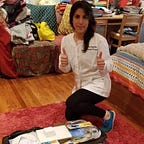Volunteering Day 1
Today we arrived at the Armenian Red Cross Society Gratsia International Rehab Center for our first day of volunteering.
We had a meet & greet with the center’s medical director, Gagik Muradyan, who welcomed us warmly. He walked us to the rehab gym and introduced us to the staff which consists of around six kinesiologists overseen by two doctors. It became apparent that rehab roles are not as delineated as in the United States — rehab clinicians play the role of both physical and occupational therapist. Mr. Muradyan explained the center has not hosted clinicians from outside in quite some time and stressed the importance of teaching the staff new treatment techniques. Over their lunch hour, we chatted with them about their needs, their backgrounds, clinical topics they were interested in learning about, and logistics of how rehab at this facility operates. At this center, there are about 25 remaining soldiers from the Artsakh conflict who are still receiving rehab services. We would be seeing a mix of those soldiers as well as other patients receiving treatment. We will also be presenting on Thursday on the topic of managing spasticity and its effect on function.
When patients were brought into the gym following lunch, we started by observing how the rehab staff conducted each session and answering any questions they had about treatment approach and ideas.
We worked with and advised clinicians on 3 patients today (names have been changed except Artak who gave us permission to be included in our article)
(1) Anto— Gentleman in his 60s who presents with left-sided weakness due to stroke, affecting his ability to walk and use his left hand during functional daily activities. His clinician Vahe guided him through lower body & leg exercises on the table mat, practiced sit to stand transfers, then walked with him, instructing him on proper use of crutch for support. I advised Vahe and worked with the patient on exercises to promote left shoulder range of motion & strength as well as activities to promote upright postural control while sitting unsupported such as functional reach activities with mirror placed in front for visual feedback for greater ease to self-correct posture.
(2) Artak — Soldier in his 20s who suffered a peripheral nerve injury affecting functioning of his left arm &hand as well as a twisted ankle causing soft tissue injury. I advised the clinician working with him, Gevork, on various upper body exercises to strengthen and increase flexibility of the left hand, arm, & shoulder, minimize spasticity of left hand, and stabilize left ankle using theraband.
(3) Takouhi — Female former dancer and performer currently in her 80s who presented with severe pain of R thumb and wrist which limited her ability to use her dominant hand during all functional daily activities. Upon examination, it became apparent to me that she likely has DeQuervain’s tenosynovitis. I instructed patient in the following: thumb immobilization with a splint (will be provided to her tomorrow), applying ice 3–4x/day x15–20min (ice pack will be provided to her tomorrow), and compensatory strategies to protect and decrease strain on her wrist. I have typed up all above treatment information and am sending it to our translator to be translated into Armenian then printed for this patient’s future reference for improved carryover and adherence to treatment plan.
We left around 4pm feeling energized and excited!
We enjoyed a change of scenery at Anteb restaurant in Yerevan, where Talin enjoyed her first ever bowl of manti! We sat for about 2–3 hours to discuss the day, devise treatment plans, and organize our upcoming presentation on managing spasticity.
